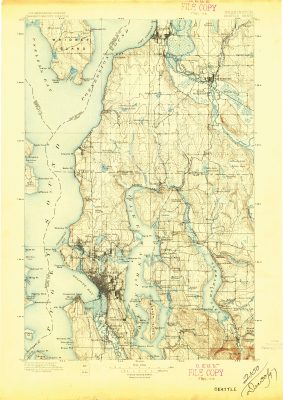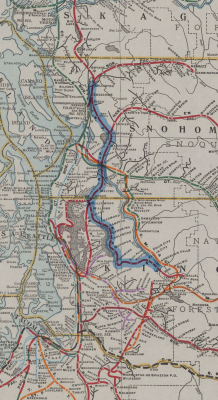This article was originally published in the December 2000 Sounder. Several locations are now known by different names. Squak Lake is now Lake Sammamish and Gilman became Issaquah in 1899
The SLS&E prompts “profuse expressions of satisfaction”
Search and retrieval by Rich Wilkens
The following article was published in the July 20, 1895, Haller City Times, now the Arlington Times. It describes a trip from Arlington to Snoqualmie Falls on the Seattle, Lake Shore & Eastern Railway.
THE SNOQUALMIE FALLS
Are Visited by a Party From Arlington.

1897 map of Seattle-Everett area showing Seattle & International (former SLS&E) trackage. Courtesy USGS.
On Saturday the 13th the employes (sic) of the S., L. S. & E. railroad were given a treat by way of free passes to and from Snoqualmie Falls. A company of about 15 ladies and gentlemen of Arlington and vicinity availed themselves of the company’s generous offer, and having provided themselves with several baskets full of toothsome delicacies, supposed to be indespensible (sic) for picnicers (sic) in general, they boarded the train at 7:50 A.M. for a 66 mile run to the falls.
Mercury that had been playing pranks in the glass for a few days previous, had become more tractable, and we glided along over the smooth steel track with the cool breeze, fragrant with the scent of flowers and new mown hay, bathing our cheeks as we comfortably reclined upon the luxurious cushions and drank in with eager eyes the beauties of the constantly varying landscape, that like a panorama of ever changing views, presented a series of delightful surprises, each more pleasurable than all the rest. An hours (sic) delay at Woodinville caused some exclamations of empatience (sic), but we were soon on our way speeding through the Squak valley, hurrying past farm houses, orchards and hay fields. Beyond Redmond the scene becomes agreeably fascinating. That beautiful sheet of water known as Squak Lake never presented a lovelier appearance than upon this occasion. For miles the train like some fascinated wooer glides in and out along the indentures and promontories that form its shores gratifying the beholders with visions of beauty at every turn. Farther on we come to the very pretty city of Gilman nestled among the hills, and after various tortuous windings to Preston where we greeted some old acquaintances, and saw a train load of mammoth fir and cedar from McDougal, Jackson & Veazie’s camp. Many of the logs measured 6 feet in diameter. Continuing to climb the mountain we pass the little station Fall City, and are soon at the falls-the pride of Washington and one of the chief wonders of the world. A few feet from the track and we stand upon a jutting precipice and look down into a seething mass of spray and foam 268 feet below. We are face to face with this wonder of the west before which combination of the marvelous and sublime we stand entranced. We involuntarily exclaim, a greater Raphael or Michael Angelo has wrought this!

This 1917 map of Washington rail lines shows the route taken by the excursionists. Map courtesy University of Washington Libraries.
The water, ceasless (sic) in its motion that in fleecy folds hides the face of the cliff in its descent, the spray shimmering in the sunshine, forming tiny rivulets on the walls of the canyon below, the rainbow changing like the transformations of a kaleidoscope, render it an exceedingly charming picture indescribable beyond measure. Art may exhaust its skill and the tongue its vocabulary of expression in their attempts to portray the matchless beauty and grandure (sic) of this masterpiece of the Great Artist.
Hundreds of pleasure seekers like ourselves were on the grounds engaged in dancing, fishing, sight seeing or picnicing (sic) under the forest shade. We crossed the swinging bridge and after partaking of a bounteous repast, spent the time till 2:30 in watching the Falls with one eye and the train with the other.
With the exception of two-hours delay at Woodinville our return trip was replete with pleasure and all were profuse in expressions of satisfaction, it having been one of the enjoyable occasions of our recent pilgrimage.
L.K. ALVORD

